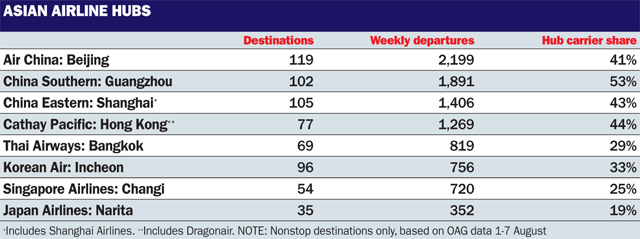The large passenger airport hubs in the Asia-Pacific region have seen higher-than-average growth rates, especially since 2000. New hubs have developed, especially in China, changing traffic patterns and reflecting economic growth.
Korean Air, Japan Airlines, Cathay Pacific and Singapore Airlines have been seen as the key hub carriers in terms of providing connecting services within the Asia-Pacific region and beyond. Their respective bases at Seoul Incheon, Tokyo Narita, Hong Kong and Singapore Changi have all benefited from the growth of their home carriers - although Narita has been affected by JAL's recent problems and Japan's weak economic growth.
 |
|---|
Max Kingsley-Jones/Flightglobal Air China's Beijing hub is now the second busiest airport in the region |
However, greater liberalisation and fast-growing market demand have resulted in new airline/airport hubs challenging the traditional ones.
Air China started its hub development at Beijing Capital International airport in 2002. The airport is now the second largest by passenger numbers in the Asia-Pacific region.
Following its example, China Southern Airlines also embarked on hub development plans at Guangzhou Baiyun airport in 2004, while China Eastern Airlines followed suit at Shanghai Pudong airport in 2007. Now, at least eight regional full-service carriers have announced hub strategies linking international markets to their main operating bases.
The top three airline and airport partnerships in China are now seen as the biggest hubs in the Asia-Pacific region in terms of network scope, passenger density and market dominance. Air China now operates 2,199 nonstop flights a week to 119 destinations from its Beijing hub, accounting for 41% of the airport's total capacity, according to OAG statistics in August 2012. China Southern and China Eastern also have a wider spread of routes at Guangzhou and Shanghai, compared with Cathay at Hong Kong or SIA at Changi.
Besides the "network scale" of a hub, however, efficiency of flight connections, origin and destination market presence, flexible connecting-flight frequencies and pricing are also important from the passengers' perspective.
Connectivity analysis shows that Cathay Pacific's Hong Kong hub is still the most attractive in terms of the lower minimum connecting time required, comprehensive network coverage for international markets and flexibility in connecting frequencies for passengers. Chinese hubs have better coverage in terms of links to domestic markets, but have poorer international connections. Part of this may be influenced by visa requirements for transfer traffic.
INTERNATIONAL LINKS
The competition between hub airlines and airports will continue to increase, but to improve hub connecting services and their attractiveness to connecting passengers, hub airports and their carriers will have to work closely to address several key issues.

These include: reducing minimum connecting times required; building a flight bank structure with good network spread and flexible flight frequencies; forming an efficient communication and cooperation scheme; and building a comfortable and attractive commercial and leisure transfer environment, taking into account issues such as transfer visas.
New Chinese hubs have benefited so far from major network growth and a large domestic Chinese market. The next step is to integrate domestic with international connections.
Source: Flight International



















